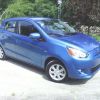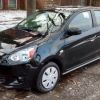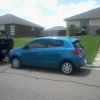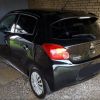 Adding Sound Dampening (DIY instructions, with photos)
Adding Sound Dampening (DIY instructions, with photos)
Hi All,
This will be a quick and dirty, tutorial on how to insulate your Mirage / Space Star from road noise. You only need about 50-75% coverage to get more-than-adequate noise reduction. Anything more, and you're probably wasting money.
Quick Details Needed To Begin
Materials Needed
- Peel & Seal Aluminum Waterproofer (Available at Lowe's and Home Depot for ~$15 USD per 25 foot roll).
- Scissors (Not your good ones, tar will get on them).
- Box Cutter (Best have a spare blade).
- Phillips Head Screw Driver.
- Flat Head Screw Driver.
- Plastic Spackling Tool or Plastic De-clipper.
- Thick work gloves (Leather is best).
Precautions
- Some moderate force will be needed to remove plastic panels inside vehicle, such as doors, etc.
- Peel & Seal Aluminum can have sharp edges.
- Do not apply dampening on wires, sensors, or any other electrical device.
- Attention must be given to which holes you cover. Some holes are for plastic clips. Some can be covered.
- Peel & Seal cannot be removed easily, if at all. Pay attention to where you stick it.
Useful Info
- Start at the back of the vehicle. Starting in the front is much harder.
- Peel & Seal Aluminum weighs about 7-10 lbs per roll.
- Peel & Seal Aluminum averages 1 to 2 mm in thickness.
- You will need anywhere from 4-6 rolls total.
- Soft rubber padding works great too, but is far more expensive.
Removing Vehicle Interior
Rear of Vehicle (Trunk and Back Seat)
You will have to remove virtually all panels. Start with the panel nearest the rear hatch. Work your way forward to the back of the seats, at which point, you may fold the seats down, and remove the panels covering the rear wheel wells. You do not, at any time, have to remove the rear seats backing. You will have to remove the bench seat, which is one single piece of foam, and can be pulled up from the floor by grabbing it at the front side, and pulling forcefully. It is held on by two metal clips.
Removing the panels is simple, but will take brute force, applied with care. On the plastic covers which cover the rear wheel wells, there is a clip which protrudes from the base, and attaches to the floor of the trunk, next to the spare tire. This clip will need to be removed with a flat head screw driver, or a clip remover. The rest is just pulling and tugging.
On the left wheel well cover, you will find a light. As you pull this panel off, ensure you unclip the light as soon as possible. The wire is short, and will be stressed almost immediately after removal of the panel.
Luckily, the rear is very easy, and takes about 1 hour or less to remove everything.
Front of Vehicle
Precaution: At this point, you will NEED to disconnect the battery. Failing to do so could result in air-bag deployment, warning lights, etc.
Step 1: Chairs
You will need to remove the front passenger and driver's chairs first. You will want to do this with the plastic panels on, as you will scratch things pulling these out, and better scratch the plastic than your delicate, thin paint.
Start by moving the chair all the way back, and remove the two cap-bolts on the front of the chair. These bolts are tight, you may need a breaker-bar for these.
After removing the black cap-bolts, proceed to move the chair forward, and remove the 2 silver, long bolts from the rear. These are once again, very tight. Breaker-bar recommended. Warning: The back bolts are of smaller diameter than the front bolts. Have your tool-set ready.
After all four bolts have been removed, you will want to tip the chair back. There are a series of connectors you need to disconnect from under the chair. Disconnect all, starting with the air-bag first. That is the YELLOW one. Disconnect it first, after grounding yourself to the metal frame (just touch it to remove static to prevent the airbags from deploying).
After disconnecting all wires, you will needed to "fiddle" with the dangling previously loose connector to get it out of the white-clip that holds it to the bottom. It opens up, sort of like a zip-tie. It's kinda tricky, and can't be explained, just try and push and knead on it, and it will magically pop open, and out comes the connector.
After that, you will need a pair of needle-nose pliers to remove the plastic clip holding the harness to the bottom of the chair. This is awkward, and difficult, so a second pair of hands might be useful to hold the chair while you pry at it.
Note: On the driver's side chair, there is an additional connector on one of the sliding rails. Find it, and remove it.
Step 2: Plastic Panels
Start by removing the plastic panels on the base of the door-entry for the front doors, and if you left them, the rear doors.
Then, using your muscular hands, pry and pull at the plastic panel that is located at the seat-belt for the front of vehicle. There is a small panel that pops off readily at the base, allowing you to remove it from the seat belt.
Next, remove the plastic clips on the panels near the foot-wells of both the driver's and passenger's side. These are the kind that you need a flat-head screw driver for to pry out. One of them is a two-part clip, requiring you to pry-open (not out) the center, and then grasp and remove the entire clip. Try not to break this one. There is an additional round-cap plastic screw just beneath the gas pedal. Unscrew that with your fingers.
Next, remove these panels. The driver's side panel has a LOT of wires beneath it. Be gentle as to not cut these wires. Otherwise, pull and tug.
Next, there is a black plastic cap that surrounds the steering-wheel column that enters the bulk-head (firewall). You will need to pry at it, and it should come up and loose. Leave it alone for now.
Step 3: Center Console
Luckily, our center console is not all that bad. Remove the plastic panel in the center, next to the parking-brake handle, as well as the panel at the rear, behind the rear-seat cup-holder. There are two bolts that you will need to remove. The second one is under one of the crash-sensors. It simply pops right out. Do not be aggressive with that sensor, it's not hard to pop out. Underneath, lies your second bolt.

After these bolts have been removed, you will need to remove the one-time plastic clips from the center-console that are forward of the vehicle, under the stereo. There's unfortunately, no way around this: you will, almost certainly, break these. They are of the fragile-plastic kind, probably designed to be put in, and never taken out, and are hard to remove without breaking. I was able to remove the left (driver's side one) in-tact, while I shattered the passenger side. A small screw can be used in-place of them, if you happen to break them.
The center console DOES have a wire for the FAST key (keyless entry) folks: The place where you'd put your FAST key, under the stereo, has a small brown wire under it. Disconnect that. And try not to forget to re-connect it later.
Step 4: Carpet
After all panels, and center console have been removed, you will need to remove three plastic clips holding the carpet in. Two are under the center-console, and now exposed. One is under the rear seat bench, in the center of the vehicle.
Next, there is a piece of velcro holding the carpet together under the stereo. Undo this velcro.
Removal of carpet is now standard: remove the wire harness from the slats cut-out in the carpet gently, and if equipped, remove the clips for the driver's side floor mat.
Next, pull the carpet out, through the rear hatch. You're done. There's some foam up front, which you can just move, and then you can lift the insulation up to place your dampening on the floor and wheel wells.
A note to the wise: most of the engine noise comes through the dash. Unless you want to remove the dash, you'll have to forget about it.
Rear Doors
Start by taking all screws off. There are 4 screws. One is in the door handle / lock, and the other in the space next to the window up/down button or the other "door handle".
Next, take a plastic de-clipper (or a plastic spatula; spackling tool) and wiggle it under the plastic piece which protrudes around the window up/down button, and "door handle". This piece is very difficult to remove. Force is required. Start from the smaller end, and work your way towards the up/down button itself, using a up/down motion to de-clip the plastic molding. After removal, unclip the up/down button.
Upon removal, you will find 2 more screws. Remove these screws. Next: use that same plastic tool, and place it under the lip of the door panel itself, and use force to remove the door panel. This is tricky, but can be done. Once you figure out the first door, all the other doors are insanely easier.

After removal, lift the panel up, and unscrew the handle / lock mechanism from the behind panel itself. It is held in place by 1 screw to the rear of the mechanism.

With the panel off, you will be greeted by a plastic sheet adhered to the door by a super-thick 1/4in round tar bead. You can either pull it off (but you'll probably tear it, I tried) or you can cut it off, and leave about an inch on it to cover the tar. Adding heat with a hair dryer can help you avoid tearing it.

Front Doors
Front doors are identical to the rear doors, with the addition of needing to remove the side-view mirror bolt cover. If you forget to remove this, it will pop out along-with the door, so don't fret over it. Ensure you take the black clip off the door frame, as it will not come off with this cover, and you must have it on the cover to put the cover back on the frame. Needle nose pliers will work well for this, as for any other plastic clips (most are white) which you may need to pry off the metal frame.
Application Of Dampener
Rear of Vehicle (Trunk and Back Seat)
Best applied wherever you hear a ringing after tapping metal surfaces. This will actually vary car-to-car slightly. Be liberal in application, 1 layer is usually plenty, and aim for 50-75% coverage. Some areas which do not ring, such as wheel wells, still need it to dampen the sound of the wheels when driving.

Use 2 layers on the wheel wells side, facing forward. Tons of noise comes from this area.

Front of Vehicle
The front is tricky as there's lot's of places to put dampener. I decided to go all out, and put it everywhere, covering about 80% of the floor with 1 layer. I then proceeded to tap on the surface, and place down a second, and in some places, a third layer to quell the bell-like resonation of some of the larger, flatter surfaces.
The space in the front foot-wells rings very badly, 3 layers here is highly recommended, especially for the passenger's side.

I forgot to take better pictures of where I applied this to front, but just take the simple advice: everywhere you can. It's not very heavy, and our car is small. Don't be afraid of putting more in than you think you need.
Rear Doors
Aim closer for 75% coverage in the doors. You don't need more than 1 layer, but 2 layers might be beneficial. I did 1 layer.

Front Doors
Aim closer for 100% coverage in the doors. Also place some on the metal outside, just beneath the plastic sheet. 2 layers recommended. I did about 85% coverage, with 2 layers. The door will sound like a Mercedes when closed. Nice solid, thump.

Last edited by BRagland; 02-01-2016 at 08:17 PM.
__________________________________________
 View my fuel log 2015 Mirage ES 1.2 automatic: 51.7 mpg (US) ... 22.0 km/L ... 4.6 L/100 km ... 62.0 mpg (Imp)
View my fuel log 2015 Mirage ES 1.2 automatic: 51.7 mpg (US) ... 22.0 km/L ... 4.6 L/100 km ... 62.0 mpg (Imp)



 2015 Mitsubishi Mirage ES
2015 Mitsubishi Mirage ES
 Reply With Quote
Reply With Quote
 2015 Test Mirage
2015 Test Mirage Swarthy
Swarthy
 2014 Mitsubishi Mirage ES
2014 Mitsubishi Mirage ES 2015 Mitsubishi European "Intense"
2015 Mitsubishi European "Intense"

